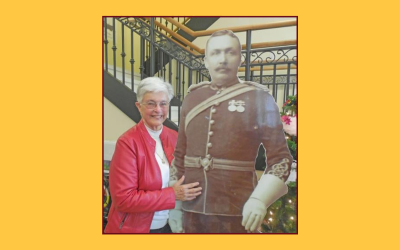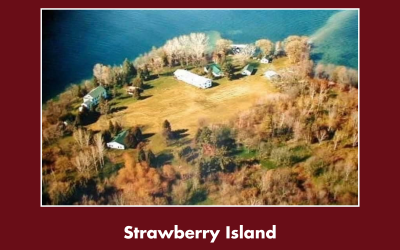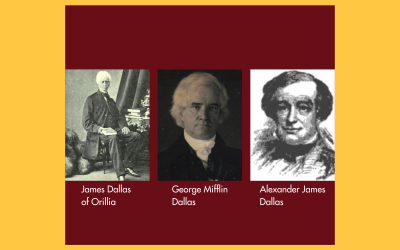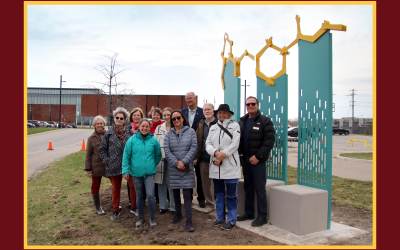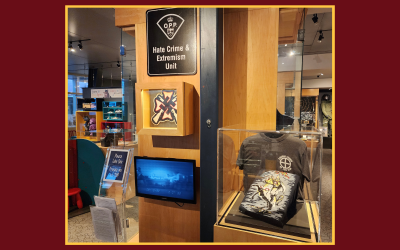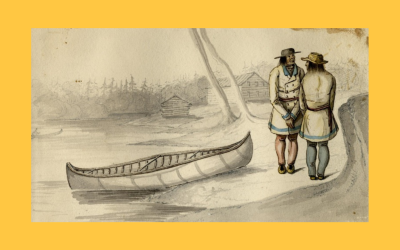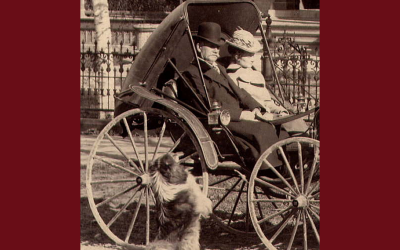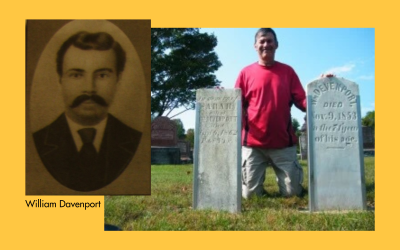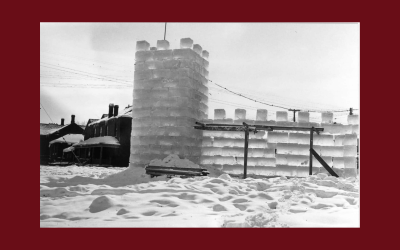A Tom Thomson Mystery

By Fred Blair
If you found the name “Tom Thomson” on the back of a landscape painting, would you think of the Group of Seven? This is a wandering tale about a painting and the possible connections between four landscape painters and Stephen Leacock.
In 1888, the Rev. Richard W.E. Greene arrived in Orillia to become the incumbent at St. James Church. Richard was known to have been painting while at Trinity College between 1866 and 1871 where he organized at least one group exhibition. About 1878, he studied landscape painting part-time at the Ontario College of Art and began to take part in painting outings with other Toronto artists. While in Orillia, Richard started the Orillia Sketch Club, taught painting in his home, and invited painters from Toronto to come up and judge the fall fair art exhibits. Franklin Carmichael studied with Richard who would also have introduced him to the city painters. Richard himself continued to make landscape painting trips with his friends from Toronto into Muskoka and Georgian Bay.
Franklin Carmichael apprenticed in his father’s carriage factory and later became head of the painting department before he left Orillia in 1911. Ruth Thomson praised the “feathered script” that Franklin had done on her father’s bread wagons. The two families may have known each other well. Franklin would return to Orillia to marry his childhood sweetheart and would later return to visit friends and family.
Richard Greene left Orillia in 1911 for Toronto as well. Franklin may have introduced Richard to Tom Thomson and other members of the Group of Seven there. In 1930, Ruth visited Franklin’s studio that he shared with Tom Thomson and other artists in Rosedale Valley. In the OMAH collection we have one of Ruth’s landscape paintings. We now have the probable connections between the four landscape painters.
Richard visited friends in Orillia and maintained his friendship with Stephen Leacock. After the publishing of Sunshine Sketches of a Little Town in 1912, Richard asked Stephen if Dean Drone was based upon him but Stephen declined to answer. Richard was working on a painting of the Leacock boat house at that time.
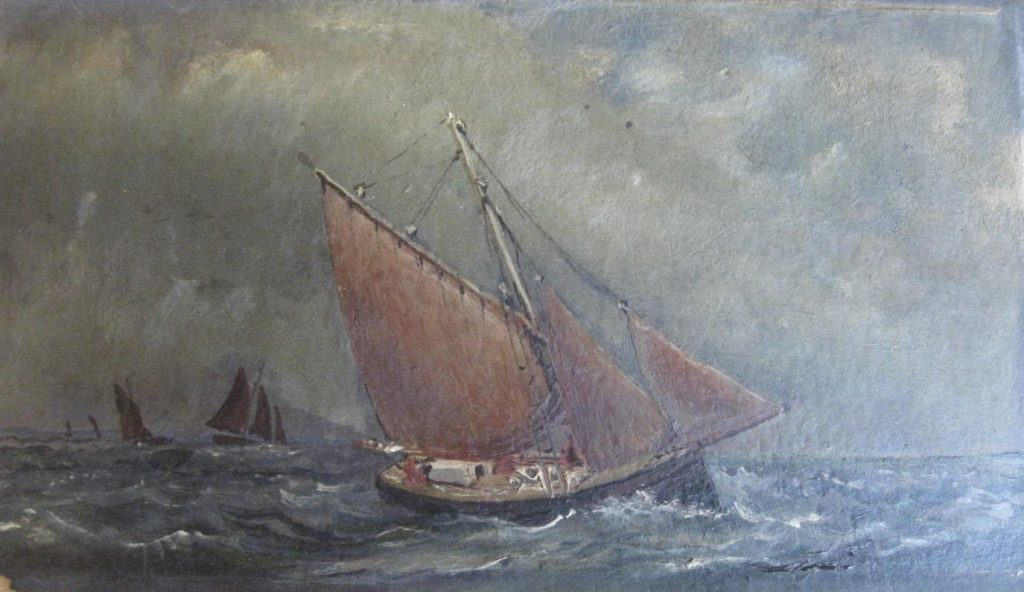
The painting of a schooner, pictured here, was titled, “Canon Green leaving Orillia for Toronto” and was inscribed, “Tom Thomson from Rev. Canon Green 2nd Oct. 17.” Richard, while a young man, had been the captain of the Governor General’s schooner on Lake Ontario, so it is quite likely that Richard left Orillia by sail. The painting was not dated or signed, which was common for Richard’s paintings. The Leacock Museum has no documentation on how the three Greene paintings there came to be in their collection.
There was at least one Tom Thomson living in the Orillia area who may or may not have been related to Ruth. It was not Tom Thomson of the Group of Seven as he died on July 8, 1917. Which Tom Thomson received the schooner painting and why was it in Stephen’s house?
Mayor William Sword Frost
By History Committee members Bruce McRae and Mary Ann Grant Recently, our own City of Orillia was featured on the popular game show Jeopardy. What could we have done to garner such attention?CLUE: IN 1912 ORILLIA, ONTARIO WAS ONE OF THE FIRST TOWNS TO TRY THIS CHANGE....
A Tribute to Jean Sarjeant
by Mary Ann Grant, OMAH History CommitteeCredit - Special to the Orillia Packet and Times - Kate Grigg Jan 12, 2017 “Dad's Diary includes tales worth telling"The Orillia Museum of Art & History (OMAH) believes that it is important to acknowledge its supporters,...
The History of Strawberry Island, Lake Simcoe
By Fred Kallin, OMAH History Committee memberAnatari, Pa-Push-Quan, Gwillam’s Island, Lundy’s Island, Creighton Island, Anderson Island, Starvation Island: these are all previous names for a small 25-acre island in Lake Simcoe we now know as Strawberry Island. Few...
The Barons of Dallas
By Fred Blair, OMAH History Committee member and Family Historian In 1835, James Dallas and his family sailed from Scotland to New York City, travelled up the Erie Canal, and made their way to Orillia. In September he purchased 100 acres between Mississaga Street and...
City unveils its newest art commission: Crossroads, Connections and Intersections
The City’s Art in Public Places Committee along with Mayor Don McIsaac unveiled the sculpture “Endorphin” by artist Camille Rajotte on April 20, 2023. The sculpture is one of nine works being installed across the city over the next several months as part of the...
A Murder Plot and the Canadian Knights of the Ku Klux Klan
Currently on display at the OPP Museum, these items were seized by OPP members during investigations. The grey Canadian Knights of the Ku Klux Klan (KKK) t-shirt was seized as part of the 1982 investigation into forged passports that turned into a killer for hire....
CHIEF YELLOWHEAD’S JUSTICE IN 1832
Indians and Canoe at Coldwater River, 1844, Titus Hibbert Ware (Toronto Public Library)By Fred Blair, OMAH History Committee member and Family Historian This is a story of an accidental killing in 1832, an unsatisfactory trial verdict, and how Chief William Yellowhead...
THE TAITS OF ORILLIA
Andrew Tait, 1896. Photo from the Orillia Museum of Art & History Archives By William Leslie, Guest Contributor This is the story of the Tait family. William Tait, his wife, Mary and family left Scotland in 1848 for Canada, travelling from Liverpool to New York...
THE DAVENPORT BROTHERS
By Fred Blair, OMAH History Committee member and Family Historian About 1810, 20-year-old Benjamin Davenport, his younger brother William, and William’s wife Sarah arrived in Upper Canada (Ontario) as former Black slaves. William was born in Virginia about 1792 and...
THE ORILLIA WINTER CARNIVAL – A HISTORY
By P. (Trish) Crowe-Grande, Chair: OMAH History CommitteeWinter weather can bring short, bone-chilling days and long, dark nights with the sun setting much too early. For many of us, it can be challenging to find engaging activities that don’t involve bingeing an...


